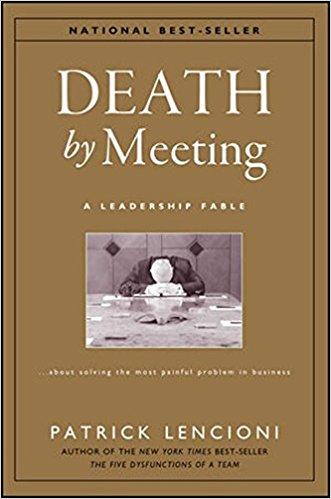Death by Meeting Summary
6 min read ⌚
 A Leadership Fable… About Solving the Most Painful Problem in Business
A Leadership Fable… About Solving the Most Painful Problem in Business
Ready for another business fable?
Well, who isn’t?
Especially if it is by Patrick Lencioni, one of the masters of the genre.
In “Death by Meeting” he tries to find a solution to “the most painful problem in business”:
Uninspiring, boring, time-wasting meetings.
Who Should Read “Death by Meeting”? And Why?
Meetings are a puzzling paradox,” states Will Peterson, one of the characters in 2Death by Meeting,” while presenting his model. “On one hand, they are critical. Meetings are the activity at the center of every organization. On the other hand, they are painful. Frustratingly long and seemingly pointless.
Needless to add, “Death by Meeting” tries to transcend this paradox.
And it should probably be consulted by every manager who wants to add some drama and context to the meetings in his company.
 About Patrick M. Lencioni
About Patrick M. Lencioni
Patrick Lencioni is an American author, motivational speaker, and the President of The Table Group.
One of the “10 new gurus you should know” according to CNN Money, Lencioni has so far written about a dozen books which explore different aspects of business management, mostly team dynamics and obstacles to success.
He is most famous as the author of “The Five Dysfunctions of a Team” and “The Advantage.”
Find out more at https://www.tablegroup.com.
“Death by Meeting PDF Summary”
“Death by Meeting” may be subtitled “A Leadership Fable,” but that only describes half of it.
Literally.
Since the book itself is divided into two very distinct parts: “The Fable” and “The Model.”
As is obvious from the titles, the first part narrates Lencioni’s story and encompasses about four-fifths of the book, providing the framework for the second part, which, in no more than 40 pages, extracts the lessons learned in the form of an applicable – and supposedly “groundbreaking” – meetings model.
Appropriately, we’ll explore the model in our “Key Lessons” section.
In this one, we’ll merely summarize Lencioni’s fable.
It concerns Casey McDaniel, the founder and CEO of Yip Software, a likable, but not at all an inspiring guy.
After winning a golf scholarship in his youth, Casey enrolled at the University of Arizona and studied electrical engineering and computers.
He wasn’t a very good student, but he was a great golfer, resulting not only in him joining the PGA tour shortly after graduating but also in winning a few tournaments and a couple of complimenting epithets.
Unfortunately, that was it for Casey, since, early on, he contracted a case of the dreaded yips, which led to him leaving the tour and inventing a virtual golf game.
The game proved a tremendous success, so Casey started Yip Software, which, by the time our fable starts, had managed to release eight mildly popular games.
Their problem?
A personal preference of Casey himself who didn’t want his four children to grow up in a world of violent games.
Unfortunately, he seems to have had no problems with his employees withering out in a corporate world of boring meetings, made even more tedious after a passionate conference or an exciting presentation by some of Yip’s competitors!
One day Casey hires an HR manager named Michelle.
For the first time in the history of Yip, Michelle organized a meeting with an agenda. And her preparations included a study on the morale of Yip’s workers.
Her conclusions?
There is no such thing in the company.
The reason?
According to Casey, the lack of a why, a motto, a mission; apparently, in his opinion, his employees needed a new cause to rally around, and they needed it fast.
According to Tim Carter, the CFO, the reason for the low morale was much more tangible: the lack of bonuses and similar financial incentives.
To this, Connor, the head of marketing, replies something which shakes Casey to the core of his existence. “I would like to make more money,” he says, “but I have accepted my fate.”
Fate?
Are all of his employees so resigned?
Soon, Casey sees no option but to sell his company to Playsoft, a rival company, and the second biggest video game market in the country.
In return, J.T. Harrison, the head of business development at Playsoft, promises Casey that he’ll get to keep his job and his team.
But Playsoft’s stocks take a plunge, and J.T. starts visiting Yip much more often, in an apparent attempt to supervise Casey’s managing more closely.
One of the first things he realizes: Yip’s meetings are as demoralizing as a modest income or a last-minute loss!
After attending one of them, he writes a mail to Casey, stating:
I have rarely seen such an unproductive, uninspired meeting in my career.
Casey fears that J.T. is angling for his job and doesn’t know where to turn for advice.
He’ll get one from an unlikely source: Will Peterson, Yip’s new administrative assistant, a brilliant guy with a psychological problem for which he takes regular medications.
However, one day he just doesn’t, and he suddenly bursts into a string of expletives during another one of Casey’s endless, pointless meetings.
Afterward, he secretly reads his CEO’s emails and finds the one sent by J.T.
So, he goes over to Casey and tells him straight away: meetings matter; yours don’t.
Casey is all ears.
And Will proposes a groundbreaking meetings model to shake things up.
Its main premise: most of the meetings are useless or wrongly conducted, lacking drama and context.
Fortunately,
There is nothing inherent about meetings that makes them bad, and so it is entirely possible to transform them into compelling, productive and fun activities.
Only four kinds of meetings are meaningful: check-in, tactical, strategic and quarterly review.
Key Lessons from “Death by Meeting”
1. The Daily Check-In Meeting
2. Weekly Tactical Meeting
3. Monthly Strategic Meeting
4. Quarterly Review
The Daily Check-In Meeting
Think of the daily check-in meeting as a football huddle!
Meaning: it should be short and conducted while standing up.
The only reason why it exists?
To help the participants quickly review their intentions and plans for the day.
And that’s it.
Weekly Tactical Meeting
Once a week, you need to organize a 45 to 90 minutes long tactical meeting.
This one should be a highly structured one, and it should include at least four parts.
First, the lightning round, during which everyone has a minute to state his or her priorities. Then, the review portion, when, obviously, everyone’s performance is reviewed against the four most important metrics.
Only after this part, you’ll be able to move on to setting an agenda and a challenge for the next week, which comprise the last two segments of the weekly tactical meeting.
Monthly Strategic Meeting
The strategy of a company should change and be updated much less regularly than its tactics, which means that a monthly strategic meeting should be just enough.
However, don’t be stingy with the time you dedicate to each of the important discussion topics during the monthly strategic meeting.
In fact, that’s exactly why you have it once a month!
Quarterly Review
Regardless of the bad reputation of quarterly reviews, dividing the work year into four quarters makes a lot of sense on so many levels, so don’t try to get rid of them.
Instead, just optimize them.
Every quarterly review should address four topics, four separate reviews: a review of strategy, a review of the team, a review of personnel, and a review of the operating environment.
Only then it can be successful!
Like this summary? We’d like to invite you to download our free 12 min app, for more amazing summaries and audiobooks.
“Death by Meeting Quotes”
No matter what kind of organization I work with – regardless of size, industry or geography – the same general experience drives people crazy when it comes to meetings. Share on X
Bad meetings, and what they indicate and provoke in an organization, generate real human suffering in the form of anger, lethargy and cynicism. Share on X
The issues you’re supposed to be talking about here are what puts bread on your tables and keeps you all employed. How much more could be at stake? Share on X
Think about your favorite movies. You can probably remember the opening scenes. Something about them got your attention and hooked you. And that’s what you have to do in your meetings. Give people a reason to care. Share on X
There is nothing inherent about meetings that makes them bad, and so it is entirely possible to transform them into compelling, productive and fun activities. Share on X
Our Critical Review
If you’ve read “The Five Dysfunctions of a Team,” you already know that Patrick Lencioni knows full well how to write an engaging business fable.
However, we feel that “Death by Meeting” doesn’t live up to the high standard he had set with his previous books.
For one, the fable is about four times as long as the model, even though the former is merely the framework for the latter.
So much so that you can easily do away with the first 200 pages and lose nothing.
There is, nevertheless, some good advice in the last 40.
So, read only those.
Emir is the Head of Marketing at 12min. In his spare time, he loves to meditate and play soccer.


 A Leadership Fable… About Solving the Most Painful Problem in Business
A Leadership Fable… About Solving the Most Painful Problem in Business About Patrick M. Lencioni
About Patrick M. Lencioni




